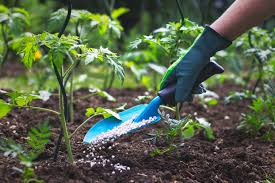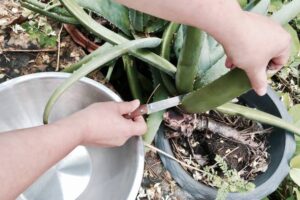Aloe Vera Farming : The aloe vera industry is one of the most profitable in the world. There are a number of industries that use it, including the medical industry, the cosmetic industry, the food industry, and many more.
It requires less water and maintenance to cultivate aloe vera. There are many health conditions that can be treated with this plant. There is a high profit margin associated with aloe vera farming. There is also a liquid and capsule version of this product.
What is Aloe Vera?
There are many conditions for which Aloe Vera is used in Indian medicine. Vera means true in Latin. There is no better medicine than aloe vera. There are 420 different plant species in the park.
There are many health benefits associated with Aloe Vera, which is a plant containing many minerals, vitamins, and other active elements. Aloe vera leaves are composed of three layers. Vitamins, sterols, glucose mannans, amino acids, lipids, and sterols compose the inner gel, which is 99% water. There are anthraquinones and glycosides in the yellow sap of the middle part of the latex. Finally, there are 15 to 20 cells on the outer layer. Proteins and carbohydrates are synthesized by them and are used to protect the innermost part. There are 160 essential elements in aloe vera leaves.
The vitamins
The vitamin A, C, and E in aloe vera play an important antioxidant role. Besides boosting immunity, it is essential for bone growth, blood production, and tooth development. To protect the body cells from premature aging, aloe vera can be used as an anti-aging formula. In addition to B1, B2, B6, and B12, it contains many other vitamins that are best for detoxification.
The polysaccharides and monosaccharides
A number of sugars are contained in it, such as antixylose, mannose, glucose, galacturonic acid, arabinose, galactose, cellulose, and aldopentose. These include antiinflammatories, antivirals, antimycotics, antibacterials, and immune stimulants.
The enzymes
There are enzymes in aloe vera such as carboxypeptidase, lipase, cellulose, catalase, peroxidase, alkaline phosphatase, ligase, bradykinase, and amylase. The application of these reduces inflammation on the skin.
The hormones
Besides auxins and gibberellins, it also has hormones. Wounds heal faster when these hormones are present. They are also anti-inflammatory.
Oils of essentials
A natural anti-inflammatory and antibacterial agent, aloe vera is packed with essential oils. The other two acids are tannic acid and salicylic acid.
Indian Aloe Vera Farming Guidelines
Aloe vera farming information is provided in the following blog. Additionally, it provides aloe vera farming tips and benefits. Aloe vera cultivation practices are also discussed in the blog.
The climate required for the production of aloe vera
There are different climate conditions in which aloe vera can grow, as it is an herb that belongs to the warm tropical crops. Climates with low rainfall, dry regions and warm, humid conditions are ideal for its cultivation. Aloe vera plants are sensitive to extreme cold. Aloe vera cannot be grown in cold climates and needs low rainfall.
The soil required for the cultivation of aloe vera
There are various types of soils that can be used to grow aloe vera. The best soil pH range for this herb is black cotton soil. Aloe Vera is best to produce in the soil that is salty in nature.
1. Cultivation of Aloe Vera

Among the Liliaceae family, Aloe Vera is a popular medicinal plant. Its height ranges from 112 ft to 212 ft. Aloe vera leaves are thick, long, and juicy. Aloe vera is grown through a process called “Phyllotaxy.” This results in a throne structure on both sides of the leaves. Leaf inner substances are jelly with a bitter taste and an unpleasant odor. Leaf lengths range from 25-30 cm whereas leaf breadths range from 3 to 5 cm. It is common to use tractors, cultivators, harrows, diggers, and other implements to cultivate aloe vera.
2.The application of plant nutrients

Before land preparation, 8-10 tonnes of FYM (farmyard manure) were applied. The amount of nitrogen (35 kg), potassium (70 kg), and potassium humate (K20 10%) per hectare should be added before the last plowing. When organic matter is high in the soil, then reduced N is applied in September-October. The quantity of Neem Cake applied per hectare is 350-400 kilograms.
3.Protection of aloe vera plants

Aloe vera plants require special care since their juice is extracted directly from their leaves. Pests and insects affect all leaves. It is essential to cultivate the plants cleanly, irrigate regularly, and apply organic manure to protect them. Using organic sources is another way to protect plants.
4.Yield of aloe vera ( Harvesting)

Harvesting should begin after 7-8 months of planting. Harvest with a knife. Juice is less likely to be lost when the portion is cut with proper care. The best time to harvest is between October and November.
A suitable climate for growing aloe vera
Agriculture is influenced by climate, as we all know. A farmer needs rainy weather or a hot climate to grow aloe vera plants. The crop needs a climate with high rainfall and high humidity.
Bright sunlight is ideal for growing aloe vera. Aloe vera agriculture thrives in high sunlight, high humidity, and high rainfall. Aloe vera grows best in high drained land with 1000-1200mm rainfall and is adapted to high drainage.
Condition of the soil
Aloe vera can be grown in any type of soil. Farmable soil with high organic matter and well-drained drainage. Shaded conditions make the disease infestation very sensitive to water stability.
The uses of aloe vera
This medicinal plant is widely used worldwide for a variety of purposes. The product is suitable for a variety of uses, including burn healing and oral health. We will show major uses of aloe vera in the following section. Check it out.
Healing from burns

The moisturizing, cooling, and soothing properties of aloe vera make it a good choice for burns. Aloe vera is also recommended by Bruning experts for burnt skin. If the burn is a sunburn or another mild burn, apply aloe vera, and if it is a severe burn, seek medical advice or assistance.
Improved digestive health

It is beneficial to your digestive system to consume Aloe Vera. The herb improves digestion and soothes stomach issues. The remedy prevents the growth of H. pylori bacteria, which causes bad digestion. Aloe vera can be poisonous, but take medical advice before using it.
Suitable for oral health

It is perfect for oral health to use aloe vera mouthwash or toothpaste. As a result of aloe vera’s antioxidants, plaque can be removed and oral hygiene can be improved. There are no side effects and it showed overall oral health. Freshens the mouth and prevents mouth odor.
The Skin Needs Care

Different skin problems can be solved with aloe vera when used for skin-care. Aloe vera is useful for skin and the face. Among its uses are dry skin, acne, scrubs, and sensitive skin. All skin types can benefit from it, whether it is summer or winter. Skin epithelial cells are taken care of by this cream. Hence, most medical experts recommend treating stretch marks and sunburns as well as reducing tan.
Aloe Vera benefits
-
The main benefit of aloe vera is its skin-care properties. It is suitable for all types of skin.
-
Aloe is the best and most profitable treatment for acne.
-
Besides being antioxidant, it is also antibacterial.
-
Weight loss was achieved with aloe vera.
-
Hair loss was reduced.
-
The cream is perfect for sunburns.
-
Medicinal plants can be used for heartburn, blood sugar control, and wound healing.
-
The side effects and risks associated with it were reduced
Aloe Vera production by country?
Aloe Vera is produced in Thailand more than any other country in the region. Aside from south-north American countries, India, USA, China, South Africa, Sri Lanka are the countries producing aloe vera.
The states where aloe vera is produced in India
One of the most popular aloe vera producing states in India is
-
Rajasthan
-
Andhra Pradesh
-
Tamil Nadu
-
Gujarat
-
Kerala
-
Maharashtra
Profits from Aloe Vera Cultivation in India
Aloe vera farming in India generates a profit of Rs. 4,72,000 per hectare. There are approximately 2,000,000 rupees in profit per acre of aloe vera cultivation.
The different names of aloe vera in India
- Musambar, Gwarpatha & Ghikanwar: Hindi
- Korphad : Marathi
- Kalabandha : Telugu
- Chirrukattalai : Tamil
- Lolisara: Kannada
- Kattawazha : Malayalam
- Kumari: Sanskrit
- Ghrithakumari : Bengali
- Kunwar ; Gujarathi
- Kumari & Mushabora : Oriya


